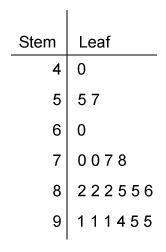
Mathematics, 21.09.2020 02:01 KallMeh
The two dot plots show the results of rolling a die 15 times on two occasions. Comparing the variability of the dot plots, which inference, if any, can you make about the result? A) The less variability of the first 15 rolls is more like the expected result. B) The greater variability of the first 15 rolls is more like the expected result. C) The greater variability of the second 15 rolls is more like the expected result. D) No inference about the result can be made using the variability of the dot plots.

Answers: 1
Another question on Mathematics


Mathematics, 21.06.2019 19:30
You have learned about the six trigonometric functions, their definitions, how to use them, and how to represent them graphically. the sine, cosine, and tangent trigonometric functions can be paired with their reciprocal functions, cosecant, secant, and cotangent, respectively. think about how each function is related to its reciprocal function.how are the graphs of the reciprocal functions related to their corresponding original functions? what happens to the graphs of the reciprocal functions as x approaches the zeros of the original functions? describe how you would teach friends with different learning styles (visual-spatial, aural-auditory, verbal-linguistic, physical-bodily-kinesthetic, logical-mathematical, social-interpersonal, and solitary-intrapersonal) how to graph the reciprocal functions
Answers: 2

Mathematics, 21.06.2019 21:30
In a test for esp (extrasensory perception), the experimenter looks at cards that are hidden from the subject. each card contains either a star, a circle, a wave, a cross or a square.(five shapes) as the experimenter looks at each of 20 cards in turn, the subject names the shape on the card. when the esp study described above discovers a subject whose performance appears to be better than guessing, the study continues at greater length. the experimenter looks at many cards bearing one of five shapes (star, square, circle, wave, and cross) in an order determined by random numbers. the subject cannot see the experimenter as he looks at each card in turn, in order to avoid any possible nonverbal clues. the answers of a subject who does not have esp should be independent observations, each with probability 1/5 of success. we record 1000 attempts. which of the following assumptions must be met in order to solve this problem? it's reasonable to assume normality 0.8(1000), 0.2(1000)%30 approximately normal 0.8(1000), 0.2(1000)% 10 approximately normal srs it is reasonable to assume the total number of cards is over 10,000 it is reasonable to assume the total number of cards is over 1000
Answers: 1

Mathematics, 21.06.2019 22:00
22. catie is starting a babysitting business. she spent $26 to make signs to advertise. she charges an initial fee of $5 and then $3 for each hour of service. write and solve an inequality to find the number of hours she will have to babysit to make a profit. interpret the solution.!
Answers: 1
You know the right answer?
The two dot plots show the results of rolling a die 15 times on two occasions. Comparing the variabi...
Questions

Mathematics, 23.10.2020 20:20

History, 23.10.2020 20:20









Computers and Technology, 23.10.2020 20:20



History, 23.10.2020 20:20


Mathematics, 23.10.2020 20:20


Physics, 23.10.2020 20:20


Mathematics, 23.10.2020 20:20




